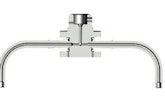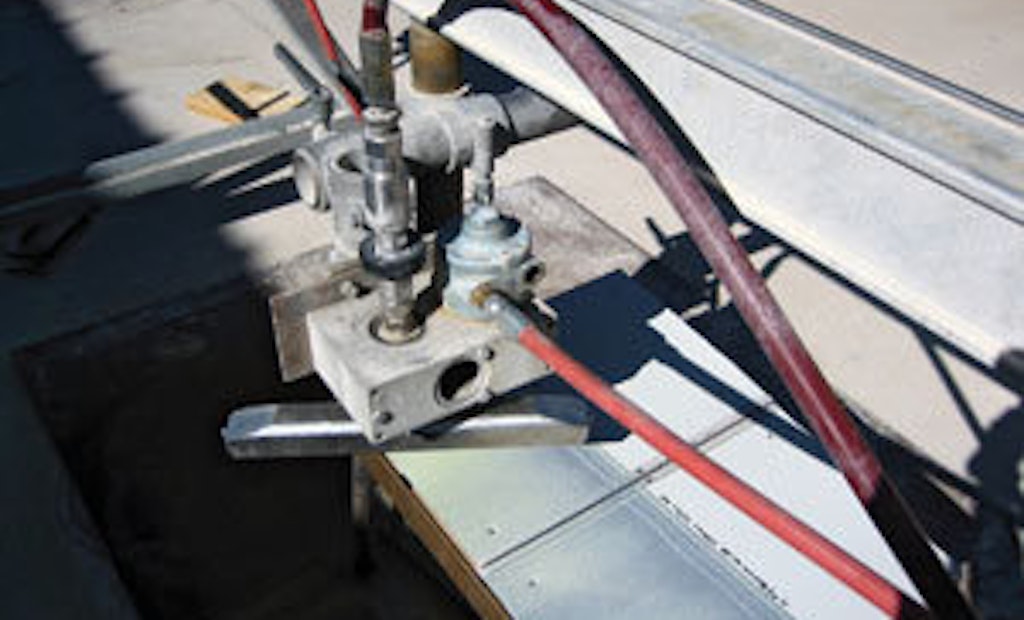Waterjet surface preparation is typically performed using pressures from 20,000 to 40,000 psi with rotating nozzle heads varying from 2 inches to 16 inches in diameter. Materials removed include coatings, oxidation and scale.
But how do variables like standoff distance, traverse speed, surface speed, rotation speed, and head design affect the efficiency of material removal? Research looking at these variables using test specimens showed that feed rate had the greatest effect on performance and also directly affected efficiency. The next strongest parameter was the design of the jetting head.
Study background
A wide variety of equipment is available for waterjet surface preparation. Most equipment now includes rotating nozzle heads. Handheld rotating guns are the most basic tools, while self-propelled machines clean much wider paths at controlled feed rates.
Variables including standoff distance, rotation speed, feed rate, and nozzle head design all affect jet performance and cleaning efficiency in surface preparation. Previous studies have focused on massive material removal at lower pressures and higher flow rates, but questions have been asked on whether these results apply at higher pressures and to the removal of thin coatings.
Tests were performed using an air-powered rotating assembly that allowed the use of various heads. The assembly was attached to a traversing mechanism with adjustable feed rates (Figure 1). Test samples were placed underneath at an angle to vary the standoff distance from 0.37 to 3.5 inches.
Commercial-grade coated steel siding trim sections were used as test samples. Effectiveness was rated by visually estimating the percentage removal of the top coating and primer. All tests were run at 35,000 psi with flows of 3 to 6 gpm. Jet path diameters of 3.6, 8.4, 12 and 14.4 inches were used with rotation speeds from 500 to 3,200 rpm.
In addition to different path diameters, two general head types were compared: a one-piece bar type (Figure 2) and a multiple-piece head with individual bent jet arms (Figure 3). The bar heads had each jet ports spaced 0.37 inch apart. The diameters given above are the largest of the jet paths.
The majority of the tests were conducted using four 0.020-inch- or four 0.015-inch-diameter sapphire orifices. Jet angles exiting the bar head and the quantity of jets were also compared.
Standoff distance
The majority of the tests were conducted with the test sample placed at an angle to produce a varying standoff distance. The predominant observation was that the jets were ineffective in removing the coating when the standoff distance was too small. Every test showed this to some degree. The region of ineffectiveness is attributed to the jet still being coherent and not yet having broken into droplets.
The other measurable effect of standoff distance occurred in relation to rotation speed – in particular the effect of standoff distance relative to multiples of orifice diameter at two rotation speeds. The maximum “too close” range varied from 0.5 to 0.63 inches with the bar head, but increased to as much as 1 inch with the bent-arm head.
In terms of multiples of nozzle diameters, this range varied from 18 to 42 times the orifice diameter for the bar heads and up to 67 times the orifice diameter for the bent arms. The most effective removal with the bar head occurred beyond 65 to 95 times the orifice diameter. In the fastest rotation speed tests, the jet effectiveness showed rapid deterioration beyond 150 to 160 times the orifice diameter.
Slower rotation speeds allowed effective removal out to 230 times the orifice diameter, which was the longest standoff distance tested. No deterioration at the maximum distance was observed using the bent arms at the fastest rotation speed tested.
Rotation speed
The rotation speed tests were designed to determine whether there is a rotation speed at which jets begin to lose power. The diameter of the jet path affects the velocity at which the nozzle tip is moving. A jet path diameter of 3.6 inches rotating at 3,000 rpm results in a velocity of 47 feet per second, while a jet path diameter of 14.4 inches rotating at 1,800 rpm results in a velocity of 113 feet per second.
Therefore, it is expected that as the jet path diameter increases, the rotation speed should be slowed to maintain an effective velocity.
Four parameters varied the effect of rotation speed on performance: standoff distance, orifice diameter, feed rate and head design. Increasing rotation speed with increasing standoff distance narrowed the effective standoff distance range.
The jet performance with increasing rotation speed deteriorated faster with a smaller orifice diameter. The effects of rotation speed made a slight difference as the linear feed rate was increased. Faster feed rate showed improvement with increasing rotation speed up to a point before performance began to decrease.
Rotation speed was tested at three jet path diameters. The 14.4-inch bar head was tested at 500, 1,000 and 1,800 rpm. The 8.4-inch head was tested at 1,000, 1,500 and 2,000 rpm, and the 3.6-inch head was tested at 2,000 and 3,200 rpm.
The feed rates were adjusted to produce the same rate of coverage; therefore the 3.6-inch head was advanced at a rate four times that of the 14.4-inch head. For the head diameters and speeds tested, the results fell on approximately the same curve, and deterioration in jet power began to occur at a velocity greater than 66 feet per second.
Feed rate
These tests showed the feed rate to have the greatest effect of all the parameters on percentage of coating removal. The 14.4-inch bar head was tested with rotation speeds of 500, 1,000 and 1,800 rpm at feed rates of 20, 30 and 40 inches per minute. Optimum efficiency occurred at 1,000 rpm and 30 inches per minute. The 8.4-inch bar head was tested with rotation speeds of 1,000, 1,500 and 2,000 rpm at feed rates of 40 and 60 inches per minute. The best performance was at 2,000 rpm and 60 inches per minute.
The 3.6-inch bar head was tested with 2,000 and 3,000 rpm at 80 and 120 inches per minute, and the best performance occurred at 2,000 rpm and 120 inches per minute.
Jet path diameter
The efficiency of jet path diameter based on the bar heads was also tested. For the three to be equally efficient, the 3.6-inch-diameter head theoretically needed to have an effective feed rate three times that of the 14.4-inch head, and that held true.
The greatest efficiency appeared with the 8.4-inch head – it produced a cleaner pass than either of the two other heads, at a feed rate of twice that of the 14.4-inch head.
The sensitivity of the larger head’s diameter curve may be another contributing factor in head diameter selection. The efficiencies of these heads are not too far apart, but if the trend were to continue beyond the diameters tested, one would expect a further loss of efficiency.
The theoretical feed rate can be calculated based on the number of jets traveling in the same path, the orifice diameter of the jets, and the rotation speed. This does not take into account the head diameter. The ratio of the actual feed rate to the theoretical feed rate for the optimum efficiency varied from 1.5 times for the largest bar head to three times for the smallest.
Jet angle
A 14.4-inch bar head with 5-degree outward-angled ports was compared to a 14.4-inch bar head with straight downward-facing ports. The angled ports removed about 15 to 20 percent more coating than the straight ports.
Bent-arm head design
The bent-arm head design was tested and compared to the bar head design. The greatest effect occurred with standoff distance. The bent-arm head showed less deterioration due to rotation speed rate as well, and the efficiency of coating removal compared to the bar head improved by 25 to 30 percent.
Nearly the same removal was achieved with the 0.015-inch orifice size in the bent arms as that achieved by the 0.020-inch orifice size in the bar head. Further testing would be required to determine if this improved efficiency of the bent-arm design could be translated directly into increased production rates.
Conclusions
The relative effects of standoff distance, rotation speed, feed rate, and head design were measured and compared in these tests. Overall, the parameter having the greatest effect on performance was the feed rate, which also directly affects efficiency.
The next strongest parameter was the head design – the bent-arm head performance was 25 percent better than that of the bar head design, and jet angle improved performance by 15 percent.
Jet path diameter appeared to reach an optimum around the 8.3-inch size range, although this was not a strong influence. Rotation speed affected performance in several ways, none being very influential.
These tests showed that increasing rotation speed is not necessarily a direct path to allowing a faster feed rate; it should be kept within a range to produce a velocity between 33 and 82 feet per second for optimum performance.
About the Authors Doug Wright is an engineer, John Wolgamott is president, and Gerald Zink is vice president and chief engineer with StoneAge, Inc., in Durango, Colo. They can be reached at 970/259-2869.








